British military narrow-gauge railways
These are narrow-gauge railways at military establishments and former UK Government-owned explosives sites. These locations were often subject to the Official Secrets Act and other government restrictions, so many of them are less well documented.
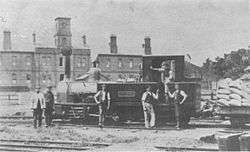
The industrial use of narrow-gauge railways was quite extensive amongst the various military and civilian explosive factories, for example ICI Nobel's works at Ardeer and the Agency Explosive Factories run by ICI Nobel in the Second World War. In another example, the Ministry of Supply (MOS) Factory Dalbeattie used 2 ft 6 in (762 mm) gauge with a variety of bogie trucks mostly pushed by teams of three to six women. Stores, explosives, chemicals, rubbish and sewage, were all transported on this narrow-gauge system, which used at least 8 miles (13 km) of track.
Weapons range railways
 Lydd ranges
Lydd ranges Redesdale ranges
Redesdale ranges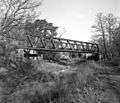 Bisley Tramway bridge
Bisley Tramway bridge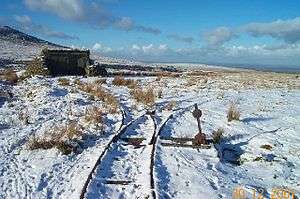
| Name | Opened | Closed | Gauge | Location | Notes |
|---|---|---|---|---|---|
| DOE Okehampton Gun Ranges[1] | ? | after 1979 | 2 ft 6 in (762 mm) | Okehampton, England | Target railway |
| DOE Redesdale Ranges target railway[2] | ? | ? | 2 ft 6 in (762 mm) | Redesdale, England | Target railway |
| Fort George Range | ? | ? | 2 ft (610 mm) | Inverness, Scotland | Target railway |
| Lydd Ranges[1] | 1936 | Present | 2 ft (610 mm) | Lydd, England | Principally a target railway, though also carries personnel and equipment around the ranges. At least 39 locomotives and powered trollies have worked here. |
| National Rifle Association Bisley Tramways[3] | 1898 | after 1971 | 2 ft (610 mm) | Bisley, England | The NRA originally had a temporary shooting range and railway on Wimbledon Common but in 1888 moved to Bisley. Initially using a Merryweather steam tram locomotive, later using diesel locomotives. |
| RAF Hell's Mouth target railway[4] | late 1930s | 1945 | ? | Abersoch, Wales | A target range railway operated by hand or rope-hauled in the dunes southeast of the airfield. |
| Romney Marsh weapons range railway[5] | before 1975 | present ? | 2 ft (610 mm) | New Romney, England | Locomotive-worked network of lines across Romney Marsh |
| Rowtor Target Railway | 1958 | ? | 2 ft (610 mm) | Okehampton, England | Disused target railway with an unmanned Wickham trolley |
Armaments depots and ordnance factories
 Chilmark depot railway
Chilmark depot railway RAF Fauld
RAF Fauld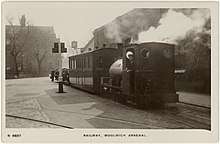 Royal Arsenal Railway
Royal Arsenal Railway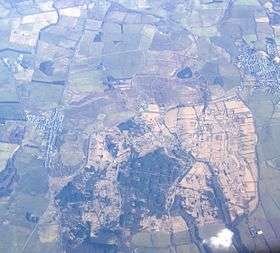 RNAD Broughton Moor
RNAD Broughton Moor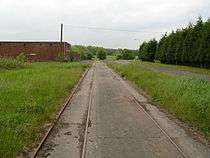 ROF Bishopton
ROF Bishopton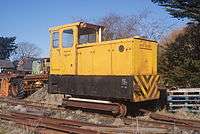 Trecwn Railway
Trecwn Railway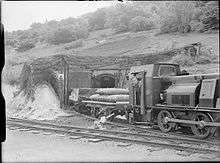
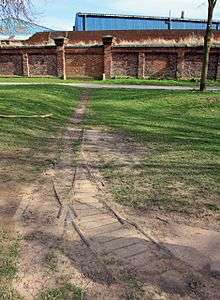
| Name | Opened | Closed | Gauge | Location | Notes |
|---|---|---|---|---|---|
| Ministry of Munitions National Filling Factory No.2[6] | World War One | ? | 2 ft (610 mm) | Aintree, England | Munitions factory supplied with early Baguley-Drewery railcars. |
| CAD Eastriggs Depot railway[7][8] | ? | closed 2012 | 2 ft (610 mm) | Eastriggs, Scotland | Extensive WW II armaments depot line using parts of the site of the former HM Factory, Gretna. A sub-depot of CAD Longtown. |
| Priddy's Hard[9][10] | about 1850 | about 1960 | 18 in (457 mm) and also later 2 ft 6 in (762 mm) | Gosport, England | Ammunition transport railway, within the Royal Naval Armaments Depot, between store houses and piers. Eight battery-electric locomotives were used after 1929. |
| Chatham Dockyard[11] | 1860s | 1930s | 18 in (457 mm) | Chatham, England | Internal rail system serving the dockyard. |
| Chattenden and Upnor Railway[11] | 1885 | 1961 | 2 ft 6 in (762 mm) | Chattenden, England | Light railway serving Chattenden barracks and armament stores |
| Davington Light Railway[12] | 1916 | 1918 | 1,000 mm (3 ft 3 3⁄8 in) | Faversham, England | Short-lived metre-gauge line serving an Admiralty munitions factory. The three locomotives were sold to Brazil where at least one survived until 1988. |
| HM Factory, Gretna | ? | 1917 | 2 ft (610 mm) | Gretna, Scotland | Extensive WW I Cordite factory line |
| Lodge Hill and Upnor Railway | 1873 | 1885 | 18 in (457 mm) | Chattenden, England | Served the construction of the Chattenden and Upnor Railway. |
| Royal Air Force Chilmark Depot railway[13] | late 1930s | 1995 | 2 ft (610 mm) | Chilmark, Wiltshire, England | Extensive WW II armaments depot lines using underground Chilmark Quarries and above-ground storage at satellite site at Dinton, Wiltshire. |
| RAF Fauld Depot railway | by 1979[1] | 2 ft (610 mm) | Fauld, England | Underground ammunition store during WWII with supply railway. | |
| Royal Arsenal Railway[3][14][15] | 1873 | 1966 | 18 in (457 mm) and 1 ft 11 1⁄2 in (597 mm) | Woolwich, England | Extensive internal rail system serving the Royal Arsenal. |
| RCAF Seaford Head target railway[7] | after 1939 | by 1945 | 2 ft (610 mm) | Seaford Head, Wales | Horse drawn target range railway about 1 mile long. |
| RNAD Broughton Moor railway[1][2] | before 1943 | 1992 | 2 ft 6 in (762 mm) | Broughton Moor, England | Locomotive-worked line hauling ammunition around the depot. |
| RNAD Dean Hill Depot railway[10][16][17] | before 1942 | 2003 | 2 ft 6 in (762 mm) | West Dean, England | Locomotive-worked line hauling ammunition around the depot. |
| RNAD Trecwn | 1938 | 1990 | 2 ft 6 in (762 mm) | Near Fishguard, West Wales | Locomotive-worked line hauling ammunition around the depot. Infrastructure built of copper to reduce sparks |
| ROF Bishopton | 1940 | 1950s - 2000 | 2 ft 6 in (762 mm) | Bishopton, Scotland | Approx 80 miles of internal rail system serving the World War II Cordite factories. |
| Royal Navy Holton Heath Cordite Factory[18] | 1914 | 1946 | 2 ft 6 in (762 mm) | Holton Heath, England | Extensive explosives factory complex using battery electric and fireless steam locomotives |
| Ministry of Munitions National Filling Factory No.7[6] | World War One | ? | 2 ft (610 mm) | Northolt, England | Munitions factory supplied with early Baguley-Drewery railcars. |
| Royal Navy Stokes Bay railway[10] | 1880s | 1919 | Stokes Bay, England | Steam locomotive worked line. | |
| Royal Navy Underwater Weapons Establishment[1] | after 1979 | 2 ft (610 mm) | Weymouth, England | Battery-electric locomotive worked line. | |
| Vickers Engineering Wyke Regis Pier railway[18] | before 1921 | 1968 | 2 ft (610 mm) | Wyke Regis, England | Pier railway used to transport torpedoes from the factory to ships. |
Supply depots
| Name | Opened | Closed | Gauge | Location | Notes |
|---|---|---|---|---|---|
| Deptford Special Reserve Depot[3] | 1916 | 1919 | 18 in (457 mm) | Deptford, England | Extensive WW I food supply depot line. At least four steam locomotives worked here, two or three of which went to the Sand Hutton Light Railway after the war. |
Fortifications
| Name | Opened | Closed | Gauge | Location | Notes |
|---|---|---|---|---|---|
| Braefoot Bay | 10 in (254 mm) ? | Aberdour, Scotland | Fortification supply railway | ||
| Flat Holm Battery | 2 ft (610 mm) | Bristol Channel, Wales | Fortification supply railway | ||
| Hoo Ness Tramway[1] | before 1914 | after 1979 | 2 ft (610 mm) | Hoo Ness, England | Locomotive-worked tramway. May have been 2 ft 6 in (762 mm) gauge previously |
| Hurst Castle[10] | 1895 | 1956 | 18 in (457 mm) | Hurst Castle, England | Line for moving ammunition and supplies around the castle. Used hand and donkey hauled wagons. Much track still in situ. |
| South Heighton railway[7] | 1941 | 1941 | 2 ft 6 in (762 mm) | Newhaven, England | Hand-worked line to aid construction of HMS Forward underground command centre. |
| Steep Holm railway[19] | 1880s | 1946 | 2 ft (610 mm)? | Steep Holm, North Somerset, England | Fortification supply railway. Palmerston forts, shown on 1886 Ordnance Survey maps. Relaid in World War II. Finally Demolished 1946. |
Training camps
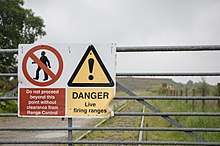
| Name | Opened | Closed | Gauge | Location | Notes |
|---|---|---|---|---|---|
| Aldershot Narrow Gauge Suspension Railway | 1872 | Unknown | 18 in (457 mm) | Aldershot Garrison | Experimental monorail |
| Kinmel Camp Railway[20] | 1914 | 1917 | 2 ft (610 mm) | St. Asaph, Wales | Locomotive-worked construction railway for the Kinmel Camp |
| Longmoor Military Railway | 1903 | 1907 | 18 in (457 mm);[21] 2 ft 6 in (762 mm)[2] | Weaversdown, England | Early 18 in (457 mm) gauge construction line used to assist in the demolition of army huts. Relaid as standard gauge starting in 1905-1907. 2 ft 6 in (762 mm) gauge line at the extensive railway training centre at Longmoor. |
| Strensall Ranges, HQ Strensall Training Centre, | 1870 | Present | 3ft 3 1/2” | Strensall, York, England | Specifically built to carry targetry to the ranges, originally 6 in number, F Range was converted to a SARTS Range and the rails were removed. Still continues to be used for its original purpose, Range trolleys are named after characters from “Thomas the Tank engine”. The system has a “siding” behind each front mantlet allowing trolleys to clear the main line. 1,165 yds long. |
| RAF Calshot Camp railway[10] | 1919 | 1946 | 2 ft (610 mm) | Calshot, England | Short line serving Calshot camp and pier. Steam locomotives were used, one of which is preserved on the Talyllyn Railway as Douglas. |
Others
| Name | Opened | Closed | Gauge | Location | Notes |
|---|---|---|---|---|---|
| Royal Navy Haslar Hospital[10] | by 1910 | 1918 | 18 in (457 mm) | Haslar, England | Hand worked line to move ammunitions and stores around the hospital site. |
See also
References
- Industrial Railway Society. (1979). Industrial Locomotives 1979: including preserved and minor railway locomotives. Industrial Railway Society. ISBN 0-901096-38-5.
- "List of 2 ft 6 in gauge railways".
- Mitchell, Vic & Smith, Keith (2003). Surrey Narrow Gauge including South London. Middleton Press. ISBN 1-901706-87-7.
- Corser, W.J.L. (April 2003). Wings on Rails: Industrial Railways in the Logistics Support of Britain's Air Defence Forces. Arcturus Press. ISBN 0-907322-85-9.
- Nicholson, Peter (1975). Industrial Narrow Gauge Railways in Britain. Bradford, Barton. ISBN 0-85153-236-5.
- Webb, Brian (1973). The British Internal Combustion Locomotive 1894-1940. David & Charles. ISBN 0715361155.
- "List of 2 ft gauge railways worldwide". Archived from the original on 2005-02-06.
- Tele Rail (1994). The Longtown Military Railway. Carforth: Tele Rail.
- Semark, H.W. (1997). The Royal Naval Armament Depots of Priddy's Hard, Elson, Frater and Bedenham (Gosport, Hampshire): 1768 to 1977. Hampshire County Council. ISBN 1-85975-132-6.
- Mitchell, Vic & Smith, Keith (2004). Hampshire Narrow Gauge including the Isle of Wight. Middleton Press. ISBN 1-904474-36-5.
- Yeatman, D. (December 1966). "Lodge Hill & Upnor Railway". The Industrial Railway Record. 12: 277–292.
- Mitchell, Vic & Smith, Kevin (2000). Kent Narrow Gauge. Middleton Press. ISBN 1-901706-45-1.
- Tele Rail (1994). Marchwood & Chilmark Military Railways. Carforth: Tele Rail.
- "Woolwich Arsenal Railway".
- Clarke, B.R. & Veitch, C.C (1986). The Eighteen Inch Gauge Royal Arsenal Railway at Woolwich. privately published by B.R. Clarke. ISBN 0-948951-00-1.
- "Visit Reports". Industrial Railway Society Bulletin. 746: 6–7. November 2003.
- "Dean Hill RNAD depot".
- Mitchell, Vic & Smith, Keith (2006). Dorset and Somerset Narrow Gauge. Middleton Press. ISBN 1-904474-76-4.
- Rendell, Stan and Joan (1993). Steep Holm: The Story of a Small Island. Stroud: Alan Sutton Publishing. ISBN 0-7509-0323-6
- Hindley, Philip G. (September 1985). "The Kinmel Camp Railway". The Industrial Railway Record. The Industrial Railway Society. 102: 309–322.
- Farmer, Keith (March 1966). "Longmoor Military Railway". The Industrial Railway Record. The Industrial Railway Society. 9: 195–205.